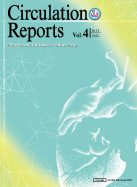4 巻, 12 号
選択された号の論文の9件中1~9を表示しています
- |<
- <
- 1
- >
- >|
Original Articles
Critical Care
-
原稿種別: ORIGINAL ARTICLE
専門分野: Critical Care
2022 年 4 巻 12 号 p. 563-570
発行日: 2022/12/09
公開日: 2022/12/09
[早期公開] 公開日: 2022/11/11PDF形式でダウンロード (1068K) HTML形式で全画面表示
Heart Failure
-
原稿種別: ORIGINAL ARTICLE
専門分野: Heart Failure
2022 年 4 巻 12 号 p. 571-578
発行日: 2022/12/09
公開日: 2022/12/09
[早期公開] 公開日: 2022/11/17PDF形式でダウンロード (1700K) HTML形式で全画面表示 -
原稿種別: ORIGINAL ARTICLE
専門分野: Heart Failure
2022 年 4 巻 12 号 p. 579-587
発行日: 2022/12/09
公開日: 2022/12/09
[早期公開] 公開日: 2022/11/26PDF形式でダウンロード (3315K) HTML形式で全画面表示
Metabolism
-
原稿種別: ORIGINAL ARTICLE
専門分野: Metabolism
2022 年 4 巻 12 号 p. 588-594
発行日: 2022/12/09
公開日: 2022/12/09
[早期公開] 公開日: 2022/11/18PDF形式でダウンロード (605K) HTML形式で全画面表示
Preventive Medicine
-
原稿種別: ORIGINAL ARTICLE
専門分野: Preventive Medicine
2022 年 4 巻 12 号 p. 595-603
発行日: 2022/12/09
公開日: 2022/12/09
[早期公開] 公開日: 2022/11/11PDF形式でダウンロード (1165K) HTML形式で全画面表示
Protocol Papers
-
原稿種別: PROTOCOL PAPER
2022 年 4 巻 12 号 p. 604-608
発行日: 2022/12/09
公開日: 2022/12/09
[早期公開] 公開日: 2022/11/12PDF形式でダウンロード (382K) HTML形式で全画面表示
Images in Cardiovascular Medicine
-
原稿種別: IMAGES IN CARDIOVASCULAR MEDICINE
2022 年 4 巻 12 号 p. 609-610
発行日: 2022/12/09
公開日: 2022/12/09
[早期公開] 公開日: 2022/10/29PDF形式でダウンロード (782K) HTML形式で全画面表示 -
原稿種別: IMAGES IN CARDIOVASCULAR MEDICINE
2022 年 4 巻 12 号 p. 611-612
発行日: 2022/12/09
公開日: 2022/12/09
[早期公開] 公開日: 2022/11/23PDF形式でダウンロード (684K) HTML形式で全画面表示
-
2022 年 4 巻 12 号 p. Content12-
発行日: 2022/12/10
公開日: 2022/12/09
PDF形式でダウンロード (684K)
- |<
- <
- 1
- >
- >|
